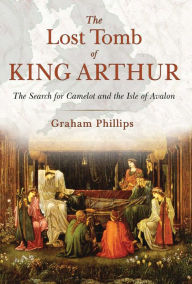I honestly wasn’t sure what to expect from this book, but the Arthurian legends are a longtime favorite of mine so I plunged in boldly and wasn’t disappointed. In fact, I learned far more about the Arthurian myths than I ever expected to, as well as about Iron Age British history. The book isn’t at all sensationalistic. It’s full of fascinating information that’s carefully pieced together to create a picture of how some real historical people and events were probably the inspiration for various bits of the Arthurian tales.
The enormous amount of information in this book is well organized into an intriguing tale of unraveling a mystery. It’s a detective story of sorts, taking the reader all over the British countryside to interesting historic sites (color photos included). I learned a lot about how the Arthurian legends developed and changed over time and about the history of Britain as well.
Phillips clearly explains his dating so I felt comfortable right from the start. He also points out the fact that he’s looking for the early historical man on whom the first legends are based, not the fanciful/mythical Arthur of the later tales. This is not a book full of glittering magic, but one full of interesting information about real life in Britain many centuries ago. The amount of detail about the Pagan religious practices that survived hundreds of years into the Christian era adds to the wars-kings-and-generals part of the history to make for a valuable read, even if you’re not that keen on King Arthur. Phillips makes it very clear where he’s laying out facts and where he’s speculating. The nice thing is, he doesn’t do much speculating. He mostly just sticks to the facts.
The author goes through the list of locations associated with Arthur (Avalon, Camelot, and so on) and shows why none of them hold up to scrutiny as actual locations with the names as given in the legends. For instance, he goes to great lengths to explain why Glastonbury isn’t Avalon, despite the popular ‘history’ to the contrary. Like the rest of the West Country, Glastonbury was saved from economic ruin a few decades ago by the popularity of the Arthurian legends. Phillips details why the bones found at Glastonbury Abbey by 12th century monks are probably a fraud. Disappointing as this may be (and as much as I’d still like to go to Glastonbury one day), the hard historical facts are clear.
This book addresses each major part of the Arthur legends separately: Camelot, the Grail, Excalibur, Avalon, Merlin, Morgan, and others. Phillips examines multiple versions of the Arthur stories and places that have been associated with those stories, tracing them back as far as the historical documentation and archaeological evidence will allow. He eliminates the information that makes no sense in terms of the Arthur story and actual British history and then focuses on what’s left.
Phillips does a great job of setting both Arthur’s 6th-century life and the medieval writers of the famous Arthurian tales in historical context so we can understand not just what was written but why, and what influenced those writings. He shows how local and regional folklore and mythology were added into the Arthurian tales at various points to please wealthy patrons or sell books. Then he peels those layers away to see what’s underneath. And what’s underneath is not at all what I expected.
The huge amount of information in this book makes it a slightly slow read, but that’s not a bad thing. Phillips includes many of the details of his research process and findings so the reader can clearly follow along and understand his reasoning. This includes some intriguing information about the history and customs of early Britain, stuff you don’t usually find in the history books.
I found it astonishing how the characters in the legends changed over time as the Arthurian tales were retold by different authors. For instance, Morgan was originally a neutral or benign character and only later became essentially a “wicked witch.” Phillips dug back to the earliest recorded versions of the tales to find any historical basis they may have come from, and what he found was very different from the way I’ve come to think about the Arthurian stories.
The earliest Arthurian tales point back to Pagan mythology and remnants of Pagan practices as Britain was slowly being Christianized. This includes lots of Celtic myths, including some lesser-known ones. Phillips searched not only through old manuscripts in libraries but also through historical ruins and ancient sacred sites to piece the original versions together.
I won’t include any spoilers, but suffice to say the author teases out the historical bits to find a reasonable identity for both Arthur and the location of his final battle. It’s all perfectly reasonable and logical, based on verifiable historical information. Phillips ultimately leaves us with no physical proof of his theory as to Arthur’s final resting place because he was unable to get funding and permission for archaeological digs at the site. Still, his reasoning makes sense. It’s not outlandish or sensationalistic in the least and it leads to a real, historical Dark Age king. That alone makes this book worth the read.
~review by Laura Perry
Author: Graham Phillips
Bear & Company, 2016
pp. 278, $18.00
The Lost Tomb of King Arthur: The Search for Camelot and the Isle of Avalon

©
2010 - 2025
Facing North
